- Reference Number: HEY312/2025
- Departments: Orthopaedics, Physiotherapy
- Last Updated: 31 March 2025
Introduction
This leaflet has been produced to give you general information about your procedure. Most of your questions should be answered by this leaflet. It is not intended to replace the discussion between you and the healthcare team but may act as a starting point for discussion. If after reading it you have any concerns or require further explanation, please discuss this with a member of the healthcare team (contact details are provided at the end of this leaflet).
What is an arthroscopic subacromial decompression?
You have probably been troubled by some shoulder or arm pain and following discussion with your consultant, they have advised an arthroscopic subacromial decompression.
This operation is performed by keyhole surgery. It involves releasing a ligament at the front of the acromion (bony process above the shoulder joint) and shaving off some bone from underneath the acromion. This will enlarge the space above the shoulder and allow the tendon to move more freely resulting in reduced friction and swelling. After the surgery you will need to take the pain medication that has been provided for you, so that the pain can be kept under control and allow for easier recovery.
How long should I wear the sling?
You will be provided with a sling to wear for comfort and can take this on and off as you wish. You should aim to stop wearing the sling within 2 to 3 days following your surgery. At night, if lying on your back, you may find having your arm raised slightly on a pillow will help with comfort.
What should I do about the wound?
Following this type of surgery, you may have small sticking plaster strips over the wounds or stitches. Keep the wounds dry until they are healed, which is normally 10 to 14 days. You can wash or shower but protect the wounds with a cling film or a plastic bag. If stitches have been used, they will be removed at your outpatient clinic appointment, which is normally 1 to 2 weeks following surgery.
When do I return to the outpatient clinic?
This is normally organised for approximately 1 to 6 weeks after your surgery.
Are there activities that I should avoid?
There are no major limits on daily activities, and you should use your arm as pain allows below shoulder height. Be aware that activities at or above shoulder height can stress the operated area, therefore repetitive or sustained over-head activity should be avoided for 3 months. Heavy lifting should also be avoided for at least 4 weeks.
When can I return to driving?
You can return to driving within 2 to 3 weeks. Check that you can manage all the controls first and preferably start with short journeys. Also check your insurance policy as you may need to inform them of your surgery
When can I return to work?
Office workers should aim to return to work within 2 to 3 weeks after the surgery. Manual workers should aim to return to work after 4 weeks, or 8 weeks for heavy manual workers depending on the severity of muscle damage.
How am I likely to progress?
The discomfort resulting from the surgery will gradually reduce over the first few weeks. Improvement in function will depend on the severity of inflammation however, within 2 to 4 weeks you should be able to move your arm comfortably below shoulder height, and above shoulder height by 6 weeks after your surgery. Improvement after 6 weeks is gradual; however, improvement will continue for up to 6 to 9 months.
When can I participate in leisure activities?
This depends on the pain, movement and strength in your shoulder. No contact sports should be performed for 12 weeks. Generally, you should initially start with short sessions of activity involving minimal effort and then gradually progress this. Be aware that powerful or sustained overhead movements such as trimming a hedge or playing racket sports will put stress on the operated area and may take longer to become comfortable.
When to attend physiotherapy outpatients?
It is essential for the successful outcome of your surgery that you attend outpatient physiotherapy following discharge. An appointment may have been arranged for you to attend physiotherapy prior to your discharge. If not, the physiotherapy outpatient department of your choice should contact you within the first days of discharge in order to arrange an appointment for 1 week from the date of surgery.
Do I need to exercise?
Yes, you must carry out the exercises in this leaflet from day 1 after surgery and continue with these until you start attending physiotherapy outpatients from 1 week after your operation. These exercises are important as they will help prevent stiffness in your arm.
Correct shoulder blade posture is important to achieve after having surgery.
In sitting or standing move you shoulder blades slightly back and down to set your shoulder blade into a neutral position.
This should be done with 10 second holds and performed regularly during the day.
You should start this as soon as possible and can be performed even when wearing the sling.
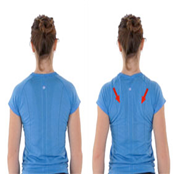
Sitting or standing leaning on a table with one hand.
Let your operated arm hang relaxed straight down. Swing your arm forwards and backwards.
Repeat 15 times, 3 to 4 times per day.
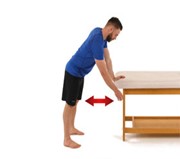
Sitting or standing leaning on a table with one hand.
Let your operated arm hang relaxed straight down.
Swing your arm to your left and then to your right.
Repeat 15 times, 3 to 4 times per day.
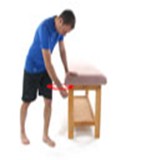
Sitting or standing leaning on a table with one hand.
Let your operated arm hang relaxed straight down.
Swing your arm as if drawing a circle on the floor.
Change direction.
Repeat 15 times in each direction, 3 to 4 times per day.
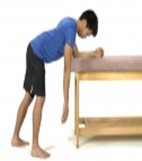
Bend your elbow and then straighten your elbow.
Repeat 10 times, 3 to 4 times per day.

With your elbow bent and palm turned down.
Turn your palm up and down rotating your forearm.
Repeat 10 times, 3 to 4 times per day.
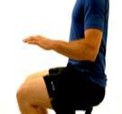
Close your fingers into a tight fist, and then slowly open them until they are fully straight.
Repeat 10 times, 3 to 4 times per day

Bend and straighten your wrist keeping your fingers straight throughout the exercise.
Repeat 10 times, 3 to 4 times per day

Sit or stand.
Lift your shoulders – relax.
Repeat 10 times, 3 to 4 times per day.
Circle your shoulders forwards and backwards.
Repeat 10 times, 3 to 4 times per day.
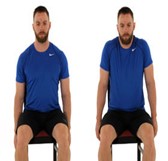
(All photos ©Physiotec™)
What happens afterwards?
Should you require further advice on the issues contained in this leaflet, please do not hesitate to contact the Physiotherapy Department on tel: 01482 674880.
This leaflet has been produced by the Hull University Teaching Hospitals NHS Trust and is available as a download:
Download the “Arthroscopic Subacromial Decompression” leaflet

